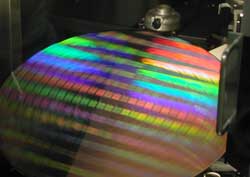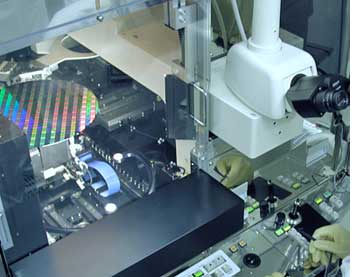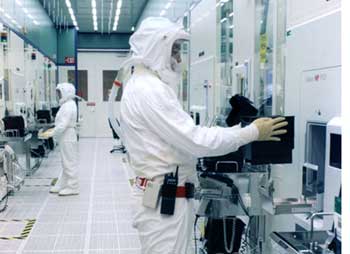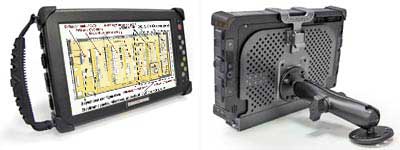|
|
Rugged tablets help to make wafer fabs greener, more efficient
Compact, versatile ruggedized COTS tablet computers add functionality to GPR systems while adding customization potential and reducing total cost of ownership.
Wafer fabrication is the process of creating the electronic chips and circuits that have become the very foundation of modern life and society. This article describes wafer fabrication, the complexity of the manufacturing steps, the numerous challenges of the process, and how standard commercial off-the-shelf (COTS) rugged tablet computers can play an important role in safeguarding every step along the way. We will also present a tablet computer solution from the Samwell Group's line of RUGGEDBOOK mobile computers.
 Overall, creating electronic circuits is one of the most complex manufacturing tasks imaginable. It all starts with silicon wafers that provide the foundation for all circuits and microprocessors. While silicon is the second most common chemical element (after oxygen), it has the interesting property of either conducting or blocking electric flows depending on how it is treated. Overall, creating electronic circuits is one of the most complex manufacturing tasks imaginable. It all starts with silicon wafers that provide the foundation for all circuits and microprocessors. While silicon is the second most common chemical element (after oxygen), it has the interesting property of either conducting or blocking electric flows depending on how it is treated.
Going from lowly sand to silicon wafers and chips is a long and complex process with numerous steps. It begins with purifying silicon until it reaches electronic grade where extraneous molecules are limited to just a few per billion. Single silicon crystals are then grown and shaped in the form of a cylinder about a foot in diameter. That silicon ingot is then sliced into thin wafers less than a millimeter thick. Those wafers, once processed and polished to a mirror-like finish, are the basis of all computer chips.
Starting with those wafers, it's then a long sequence of steps to apply various materials, using photolithography to change the electrical and chemical properties of parts of the layers. In the end, an immensely complex framework of  gates becomes the tens and hundreds of millions of transistors that make up a modern microprocessor. The etching, washing, metal deposition, and layering processes required to make a chip demand a level of microscopic precision, control and execution that is almost beyond imagination. gates becomes the tens and hundreds of millions of transistors that make up a modern microprocessor. The etching, washing, metal deposition, and layering processes required to make a chip demand a level of microscopic precision, control and execution that is almost beyond imagination.
Each of those slender silicon discs can contain hundreds or thousands of chips that are then individually tested for functionality before the wafer disc is sliced into tiny squares or rectangles, with the faulty ones being discarded. The ones that pass are then packaged into standard integrated circuits to be used in electronics ranging from smartphones to computers to all the millions of machines and household items that are now electronically controlled.
Dust is the ultimate enemy in wafer fabs, requiring clean rooms where the concentration of airborne particles is controlled to specified limits. Inside these clean rooms, humans and machines perform hundreds to thousands of processings steps. As much as possible is automated, requiring a large number of different robots and machines, each doing different tasks, having different operating and maintenance requirements, and having different repair procedures and parts lists.
 Interestingly, while the actual wafer and chip manufacturing process is almost 100% automated, checking and patroling all those machines and processes isn't always. Often at least part of it remains a manual procedure with manual controls, lots of paperwork, and all the waste and potential for error that entails. This is where an automated control system with flexible data capture options can make the difference between smooth operation and costly (and potentially disastrous) errors. With the additional benefit of eliminating the waste of a lot of paper. And this is where there is great potential for tablet computers to automate those steps. Interestingly, while the actual wafer and chip manufacturing process is almost 100% automated, checking and patroling all those machines and processes isn't always. Often at least part of it remains a manual procedure with manual controls, lots of paperwork, and all the waste and potential for error that entails. This is where an automated control system with flexible data capture options can make the difference between smooth operation and costly (and potentially disastrous) errors. With the additional benefit of eliminating the waste of a lot of paper. And this is where there is great potential for tablet computers to automate those steps.
Standard consumer media tablets, however, are not designed and built for this kind of job. And neither are conventional laptops or most industrial tablet computers. In order for a tablet to be used in a demanding environment such as wafer fabs, it must not only provide the requisite computing and communications functionality, it must also fulfill the following requirements:
- Be fanless as the presence of a fan and its resulting air movement would instantly disqualify a device from use in cleanrooms.
- Offer flexible automated data capture options such as RFID, 1D laser scanner or 1D/2D imager.
- Have all the required communications features (WiFi, GPS, WWLAN, Bluetooth, etc.) to reliably facilitate positioning, instant communication, lookups, data capture and data capture/tracking.
- Offer flexible I/O configuration including legacy serial device support.
- Offer optional portless configurations for operation in secure environments. This may include removal of USB ports and sealing of other ports.
- Run industry standard operating system platform that seamlessly ties into secure IT infrastructures.
- And finally, be built to withstand vibration, drops, temperature extremes as well as other environmental testing as outlined in MIL-STD-810G or other pertaining testing procedures.
 The picture to the right shows a Samwell RUGGEDBOOK SR820 tablet computer with a 8.9-inch daylight-readable display that is large enough to show a wealth of information (including complex schematics and manuals), but not too large to get in the way of routine patrol management tasks or confine the device to be used on a desk. IP65 sealing means the unit is largely immune to liquids and is easily cleaned. And the SR820 has passed numerous environmental tests, including shock and vibration. The picture to the right shows a Samwell RUGGEDBOOK SR820 tablet computer with a 8.9-inch daylight-readable display that is large enough to show a wealth of information (including complex schematics and manuals), but not too large to get in the way of routine patrol management tasks or confine the device to be used on a desk. IP65 sealing means the unit is largely immune to liquids and is easily cleaned. And the SR820 has passed numerous environmental tests, including shock and vibration.
The Samwell RUGGEDBOOK SR820 provides Windows functionalty and performance in a rugged tablet form factor. Measuring just 10.1 x 6.2 x 1.5 inches and weighing under three pounds, the SR820 is smaller and lighter than full-size rugged tablets without requiring many compromises. There is good wired connectivity on board, all connectors are standard size, and there is a wealth of wireless functionality (including available GPS and 3.75G radio) and also an integrated camera and optional data capture functionality. The device can easily be carried and just as easily mounted on various types of carts or workstations.
Relevant Information:
— Samwell Group RUGGEDBOOK Rugged Tablet PC-SR820 page
To learn more about the ruggedized Samwell SR820 tablet computer and its many applications, email RUGGEDBOOK at info at ruggedbook.com.tw. And check RuggedPCReview.com's description of the rugged Tablet PC SR820.
RUGGEDBOOK Headquarters
Samwell Building
317-1, Sec. 2,
AnKang Rd., Xindian Dist.
New Taipei City 23153, Taiwan (R.O.C.)
Telephone: 886-2-2214-1133
Fax: 886-2-2215-5458
Web: www.ruggedbook.com.tw
info@ruggedbook.com.tw
|





 Overall, creating electronic circuits is one of the most complex manufacturing tasks imaginable. It all starts with silicon wafers that provide the foundation for all circuits and microprocessors. While silicon is the second most common chemical element (after oxygen), it has the interesting property of either conducting or blocking electric flows depending on how it is treated.
Overall, creating electronic circuits is one of the most complex manufacturing tasks imaginable. It all starts with silicon wafers that provide the foundation for all circuits and microprocessors. While silicon is the second most common chemical element (after oxygen), it has the interesting property of either conducting or blocking electric flows depending on how it is treated.
 gates becomes the tens and hundreds of millions of transistors that make up a modern microprocessor. The etching, washing, metal deposition, and layering processes required to make a chip demand a level of microscopic precision, control and execution that is almost beyond imagination.
gates becomes the tens and hundreds of millions of transistors that make up a modern microprocessor. The etching, washing, metal deposition, and layering processes required to make a chip demand a level of microscopic precision, control and execution that is almost beyond imagination.
 Interestingly, while the actual wafer and chip manufacturing process is almost 100% automated, checking and patroling all those machines and processes isn't always. Often at least part of it remains a manual procedure with manual controls, lots of paperwork, and all the waste and potential for error that entails. This is where an automated control system with flexible data capture options can make the difference between smooth operation and costly (and potentially disastrous) errors. With the additional benefit of eliminating the waste of a lot of paper. And this is where there is great potential for tablet computers to automate those steps.
Interestingly, while the actual wafer and chip manufacturing process is almost 100% automated, checking and patroling all those machines and processes isn't always. Often at least part of it remains a manual procedure with manual controls, lots of paperwork, and all the waste and potential for error that entails. This is where an automated control system with flexible data capture options can make the difference between smooth operation and costly (and potentially disastrous) errors. With the additional benefit of eliminating the waste of a lot of paper. And this is where there is great potential for tablet computers to automate those steps.
 The picture to the right shows a Samwell RUGGEDBOOK SR820 tablet computer with a 8.9-inch daylight-readable display that is large enough to show a wealth of information (including complex schematics and manuals), but not too large to get in the way of routine patrol management tasks or confine the device to be used on a desk. IP65 sealing means the unit is largely immune to liquids and is easily cleaned. And the SR820 has passed numerous environmental tests, including shock and vibration.
The picture to the right shows a Samwell RUGGEDBOOK SR820 tablet computer with a 8.9-inch daylight-readable display that is large enough to show a wealth of information (including complex schematics and manuals), but not too large to get in the way of routine patrol management tasks or confine the device to be used on a desk. IP65 sealing means the unit is largely immune to liquids and is easily cleaned. And the SR820 has passed numerous environmental tests, including shock and vibration.
